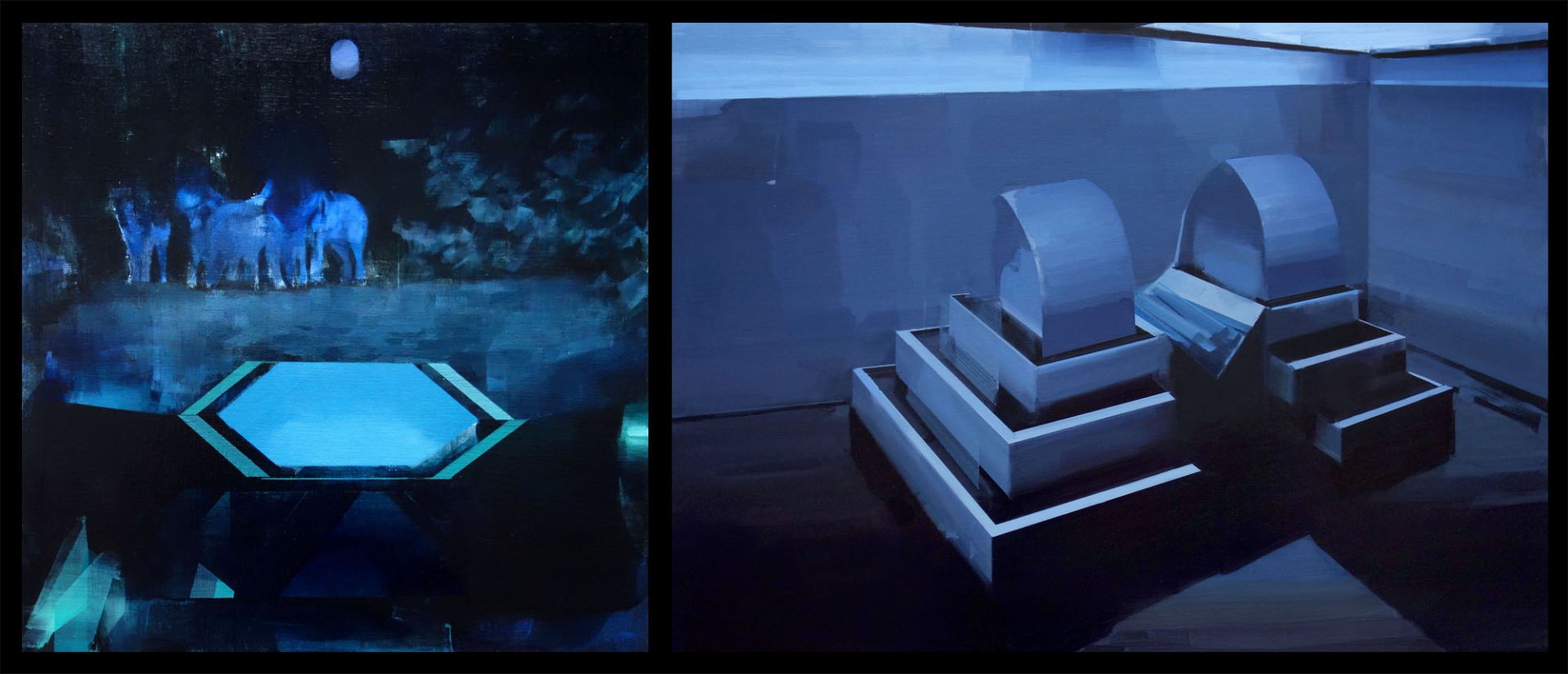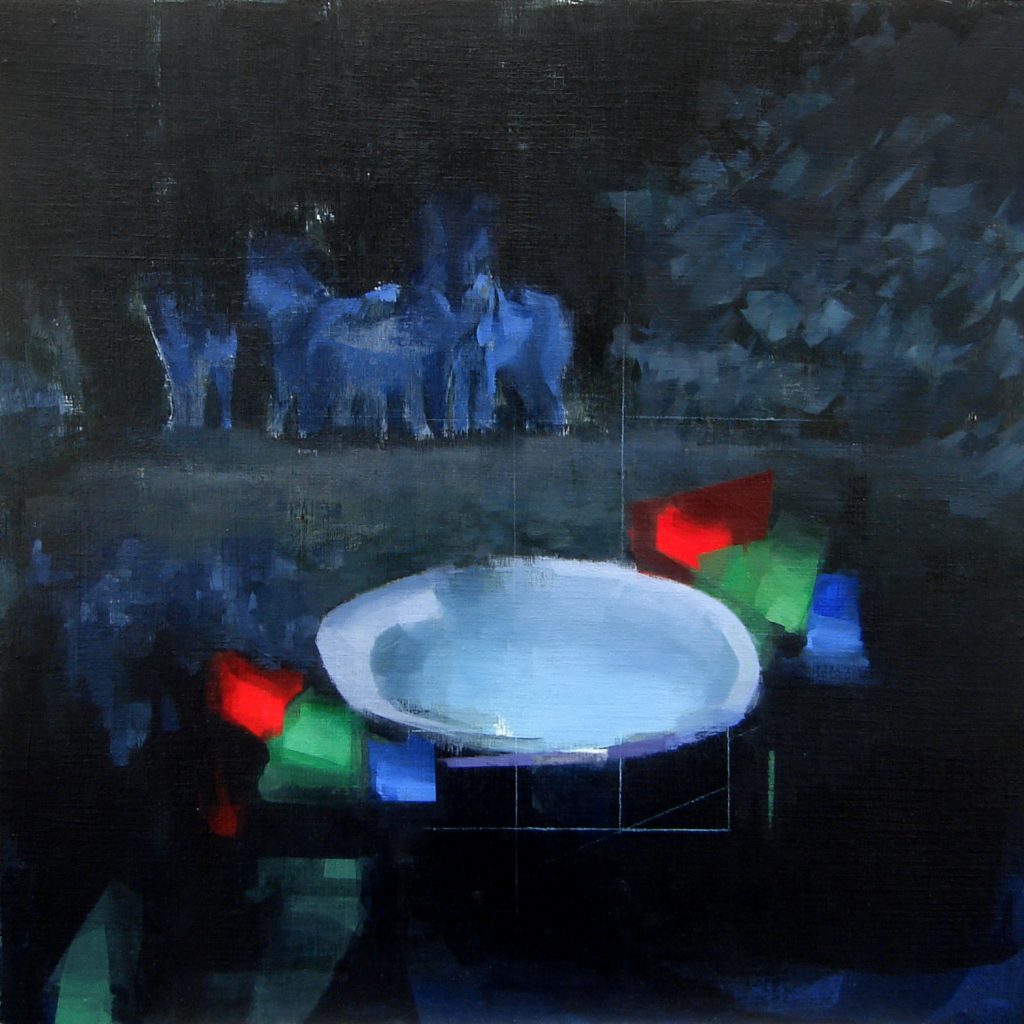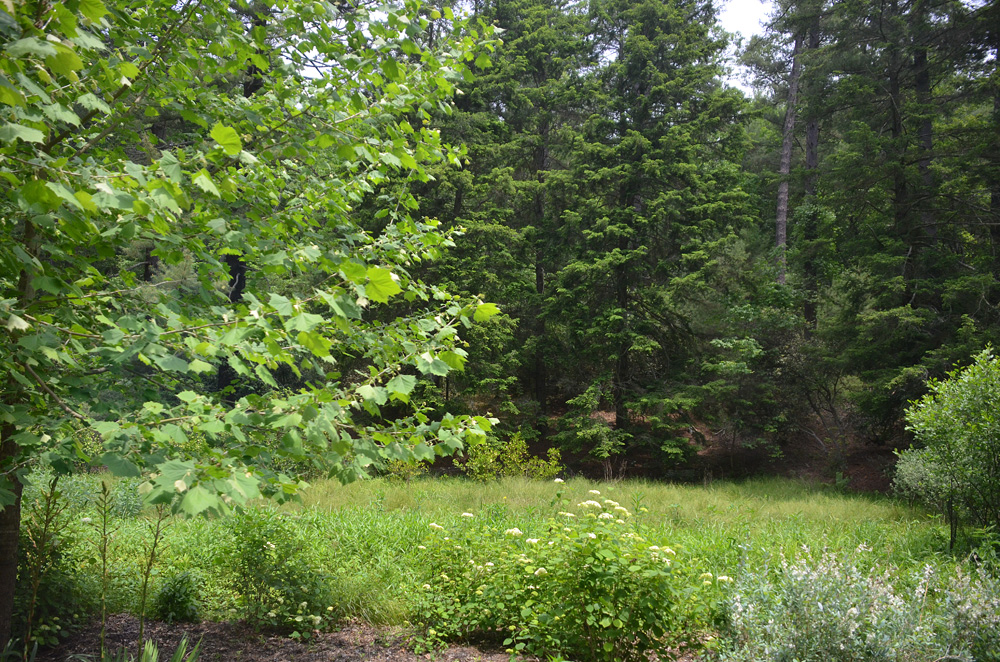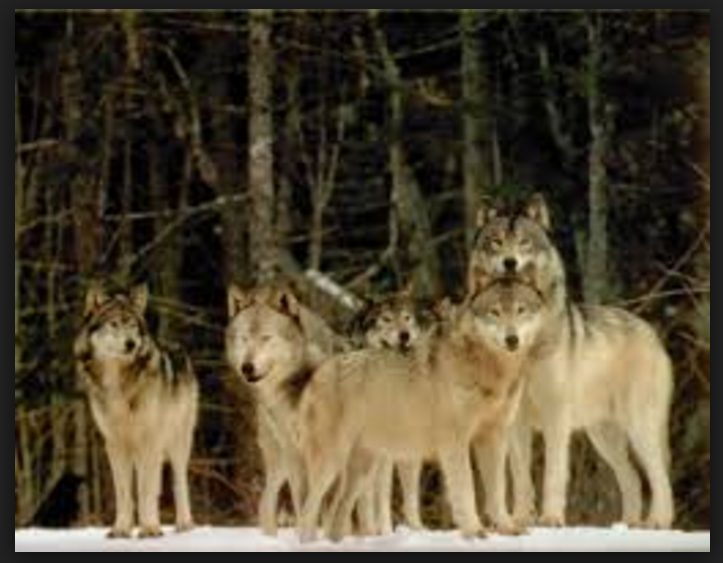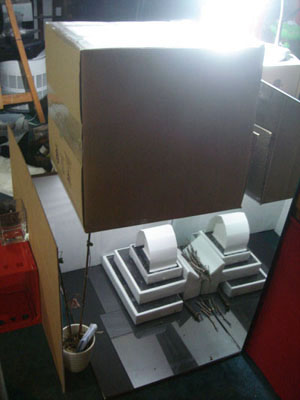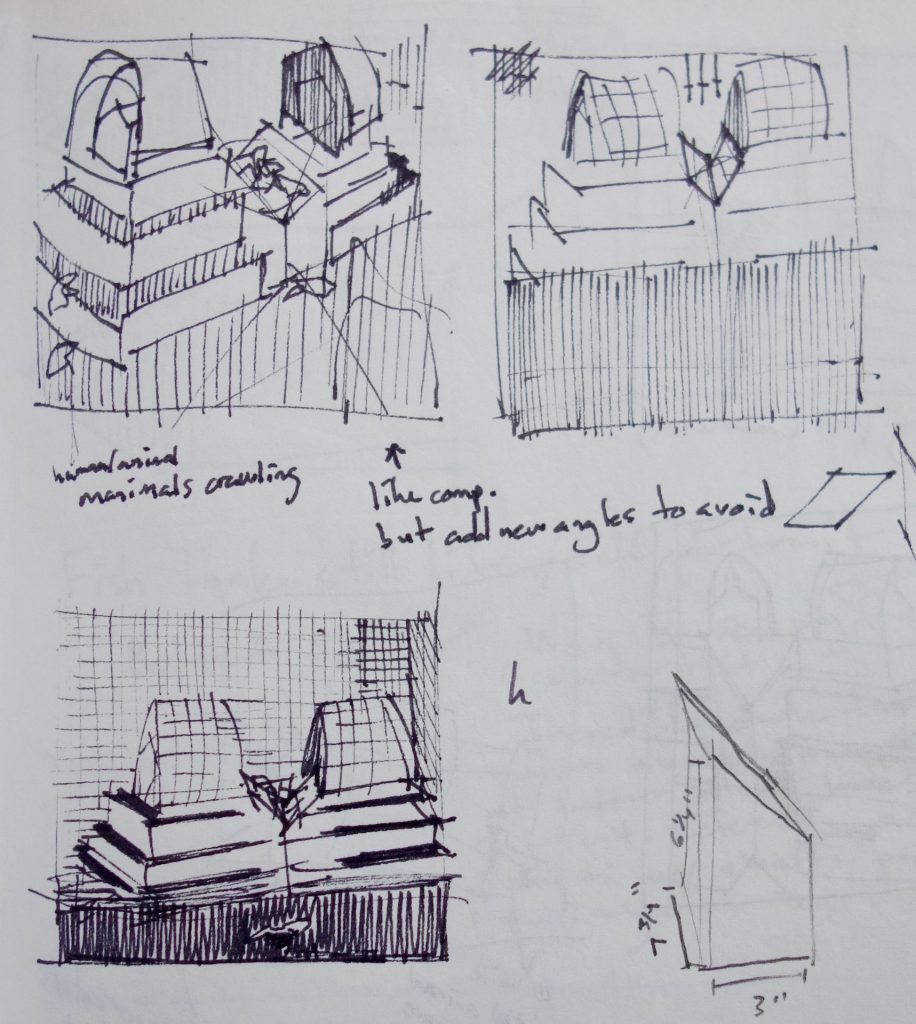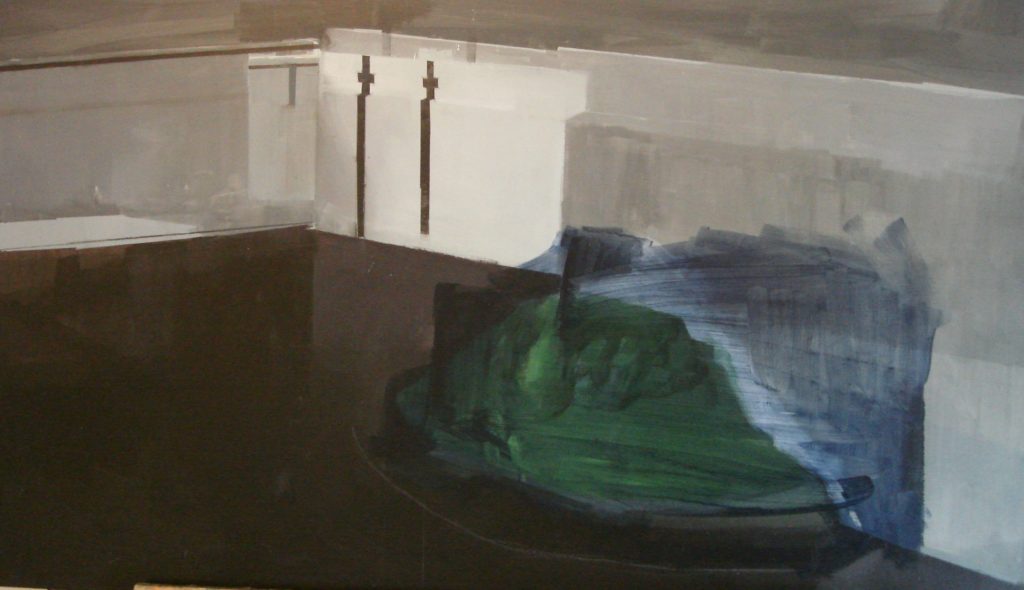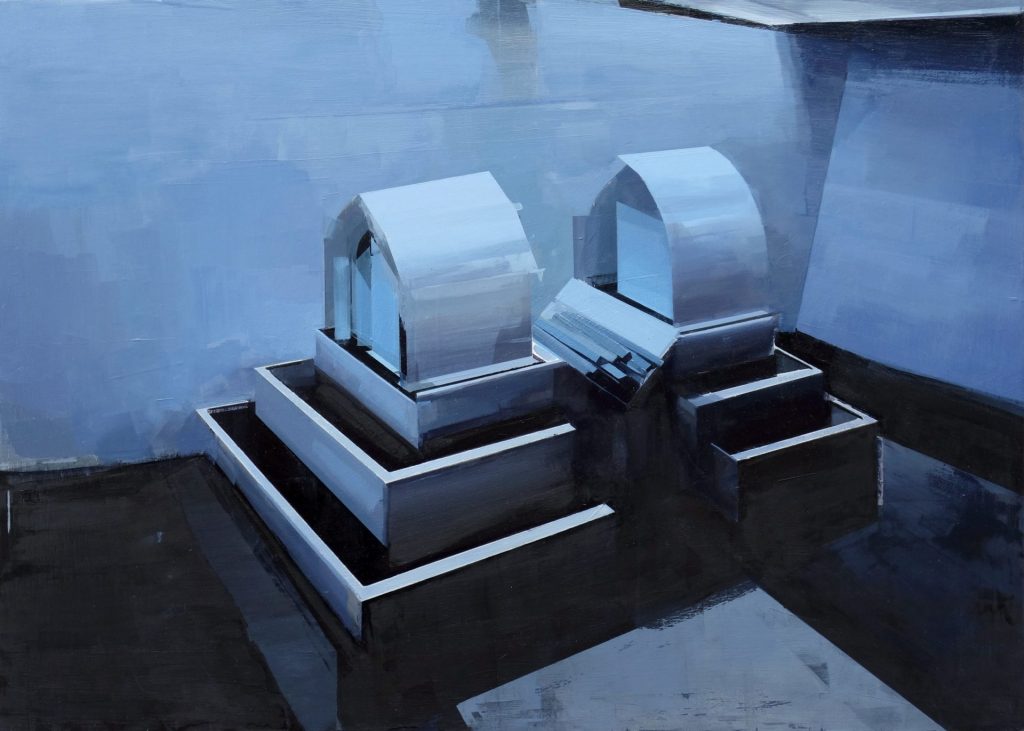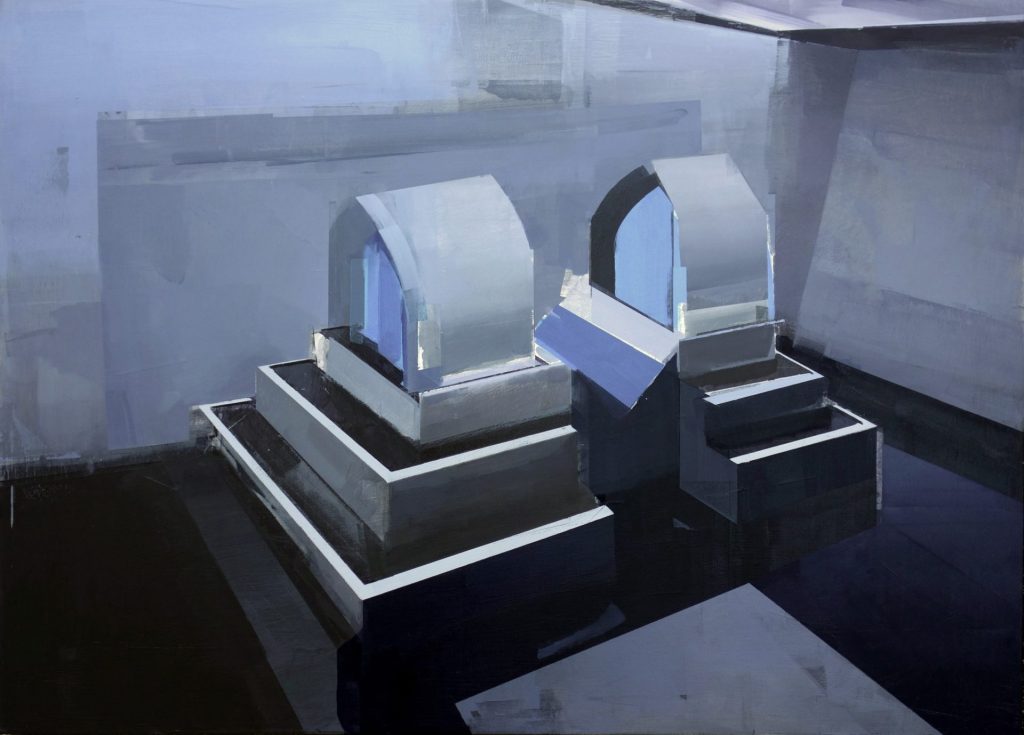While working on my two pieces “Wading Pool” and “Maruta (Waiting Pool)”, I’ve always seen them as being connected and essentially parts of a diptych even though they’re constructed as separately framed pieces. I view them as psychological landscapes – Wading Pool specifically encapsulating the idea of birth, egocentrism, intoxication, cyclical movement and naiveté, and Maruta representing the opposite end of the spectrum: sobriety, knowledge, disenchantment, linear movement, death. Both pieces have taken on multiple forms and Maruta is the third of three separate attempts, the earliest of the two previous paintings going as far back as Jan. 2013 (both were discarded).
In preliminary sketches, I remember having specific moods in mind that I wanted to capture in both pieces. They were all deeply personal and derived from some vague mixture of nostalgic remembrances from early childhood, as most of my work seems to be. I imagine this is a shared trait among most artists: the desire to re-experience emotionally charged early experiences and reconcile them with our adult experiences. I can honestly say that every painting I’ve ever made for myself has been inspired by childhood fantasies, compelled by some confusing bundle of dreamy impressions that, with the passing of time further obscuring them, have become almost like dear friends that I attempt to memorialize and hope to one day revisit. Memories from a time when my life experience was as limited as it ever would be, I was at my most vulnerable and defenseless, and the emotional bonds formed between myself and my surroundings were not yet broken by self awareness, knowledge and cynicism.
It’s always interesting for me to stand back and observe how much the moods, symbols and style of execution in a particular painting can gradually evolve over time. For example, the scene portrayed in Wading Pool originally took place at dawn, there were no wolves, there were rainbow colored light bars flanking the pool (constructed from photos of police sirens), and the perimeter of the pool was oval instead of hexagonal.
Wading Pool may be trying to illustrate my childish vision of what a clearing in the woods would look like in the midnight hours, at an age when I had never actually been awake (lucidly at least) during these hours in my own familiar surroundings let alone some distant wilderness. This span of time was still a mystery to me and so, like all children, I was free to use my imagination to fill in the gaps left by ignorance. As with most of my current work, there are technically no human figures to be seen, but to me there is still a human presence in various forms. I imagine the small pool to be either an incubator or a cradle that a child could be placed in, or the pool could represent the child itself. I tried to create a safe haven within the landscape marked by visible boundaries, a controlled environment within a chaotic one representing either the literal place that one grows up in or a materialization of the culture we are born into, the version of reality that’s imposed on us at an early age by our caretaker(s). The wolves could be those caretakers, protective and serving as interpreters of the wilderness, or they could collectively represent the crude reality we are eventually forced to come to terms with. They might symbolize the potentially violent nature lurking within the human caretakers we are born trusting in, or maybe they’re the animalistic side of ourselves we have yet to discover.
Both Wading Pool and Maruta were originally based off of digital collages, but after a prolonged struggle with capturing the realism I wanted for Maruta, I ended up building a small scale model essentially recreating the interior I had pieced together in the collage. This allowed me to control the amount of overhead lighting and accurately perceive how the light would illuminate the walls, objects, and surrounding water (using pieces of masonite covered with graph paper, a light diffusing box, a mirror, card stock, painted wooden sticks and plate glass over black cardboard). My lack of experience in creating small scale models and a shortage of sufficient modeling materials resulted in a grueling passage of time filled with a lot of trial and error, until I finally settled on the right interior and a photo that captured it the way I’d imagined.
Maruta originally included walls covered with white tiles, black crosses and the overhead lighting, while still being generated by soul-sucking fluorescent bulbs, was stark and blinding, exposing every seam of the space and attempting to serve as the emotional converse of the heavily obscured Wading Pool.
I think the original mood of Maruta may be partially linked to memories of taking swimming lessons at 4 or 5 yrs old in the large indoor pool at the Park & Rec. Department in my hometown. Over the course of the painting process, the environment eventually dimmed to what may be memories from my first visit to a planetarium, another very large room to a small child, staring up at the false night sky and taking in the under lit periphery along the walls of the dome.
Maruta, as mentioned earlier, signifies adulthood, logic and death, but it retains some elements of Wading Pool in that the unseen human presence, although under the assumption that they now see life for what it is, is still in some way deluded. Maruta also carries over an old tendency of mine to create a kind of obstacle course environment that I picture someone or something navigating through to the end. I see a symmetrical structure surrounded by dark water, a series of steps emerging on either side leading up toward the two domes, narrowing as one climbs toward the topmost holographic layer contained under the dome, finally lured in and discarded into the central pile as maruta (Japanese for “logs”).
“Maruta” was the term given to incoming test subjects sent to a Japanese medical experimentation lab called Unit 731 during WW2. It was a way for the research staff responsible for some of the most horrific human experimentation on record to dehumanize their subjects and presumably make their work more efficient. I viewed the interior of Maruta to be much like a concentration camp or a slaughterhouse – a place where a human being is viewed as a test subject, only to have its life force extinguished and body disposed of when it’s no longer useful.
The semi-transparent planes sitting on each step could represent the mental lures that we bait ourselves with in order to propel us forward and serve our underlying purposes as human beings, which to me (at my most sullen) boil down to surviving, reproducing, nurturing offspring and dying. I think our minds tend to coat the triggers for our basic urges with whatever lofty characteristics we require in order to motivate us to act on them; we transform potential mates into unattainable objects of adoration, pair-bonding into spiritual connection, the protective instinct of parents into unconditional love, and many of us are eventually unable to face death without turning to religion, hoping we will transcend it and end up somewhere better. Because we’re a species that requires a sense of personal significance while we pass through our life cycle, the delusions we produce in order to satisfy our need for purpose and peace of mind are myriad. If we’re unable to convince ourselves that we are of any inherent value, then we find our worth through a sense of belonging to something greater; our purpose is not to create but to carry out the will of the creator, even if in the most menial ways.
The assumption that the universe is spiritless, savage chaos and that anything uniquely human can be boiled down to animal urges has, sadly, always felt like the most reasonable explanation to me. But it has also always felt a bit too simple; a worldview spawned by brilliant scientific minds seeking order but possibly tainted by mental rigidity, destructive thought patterns and, perhaps, contempt for the non-brilliant masses. In some ways it feels as limited and filled with holes as organized religion, just heading in the opposite direction, and I like to think that the truth probably lies somewhere between the two extremes.
It’s obviously much easier to destroy than to create, and this destructive way of thinking is something I’ve always grappled with in my life. I decided I should paint it so that I could externalize the negative cyclical thinking and get a good look instead of holding on. When I jotted some of these possible themes in my sketchbook beforehand, I felt apprehension because I didn’t want to advertise myself as someone who has settled on how the world works and is now sharing it with people (through both the paintings and these explanations). This being said, I was never under the impression that anyone but myself would have any idea what was going on in either piece. I certainly wouldn’t know what they were about if I hadn’t painted them. I guess it feels like a disservice to the viewer and to myself to put out something that obviously needs to be deciphered and not ever want to talk about it.
I imagine most of what I express in my art, whether it’s through symbolic images or palette choices, as being paired with a subtext of “maybe?” This, to me, is the beauty of art: you don’t need total conviction. You can start playing with an idea and abandon it just as quickly as you started – no need to stand unflinchingly like a politician behind a set of ideals and hope you don’t get caught being unsure of yourself. Creative expression takes nothing for granted. It’s an endless search for meaning and a celebration of all-important nonsense.
